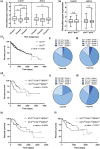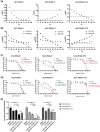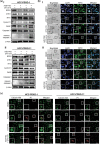Splice-switch oligonucleotide-based combinatorial platform prioritizes synthetic lethal targets CHK1 and BRD4 against MYC-driven hepatocellular carcinoma
- PMID: 36684069
- PMCID: PMC9842033
- DOI: 10.1002/btm2.10363
Splice-switch oligonucleotide-based combinatorial platform prioritizes synthetic lethal targets CHK1 and BRD4 against MYC-driven hepatocellular carcinoma
Abstract
Deregulation of MYC is among the most frequent oncogenic drivers in hepatocellular carcinoma (HCC). Unfortunately, the clinical success of MYC-targeted therapies is limited. Synthetic lethality offers an alternative therapeutic strategy by leveraging on vulnerabilities in tumors with MYC deregulation. While several synthetic lethal targets of MYC have been identified in HCC, the need to prioritize targets with the greatest therapeutic potential has been unmet. Here, we demonstrate that by pairing splice-switch oligonucleotide (SSO) technologies with our phenotypic-analytical hybrid multidrug interrogation platform, quadratic phenotypic optimization platform (QPOP), we can disrupt the functional expression of these targets in specific combinatorial tests to rapidly determine target-target interactions and rank synthetic lethality targets. Our SSO-QPOP analyses revealed that simultaneous attenuation of CHK1 and BRD4 function is an effective combination specific in MYC-deregulated HCC, successfully suppressing HCC progression in vitro. Pharmacological inhibitors of CHK1 and BRD4 further demonstrated its translational value by exhibiting synergistic interactions in patient-derived xenograft organoid models of HCC harboring high levels of MYC deregulation. Collectively, our work demonstrates the capacity of SSO-QPOP as a target prioritization tool in the drug development pipeline, as well as the therapeutic potential of CHK1 and BRD4 in MYC-driven HCC.
Keywords: MYC synthetic lethality; RNA therapeutics; quadratic phenotypic optimization platform; splice‐switch oligonucleotides.
© 2022 The Authors. Bioengineering & Translational Medicine published by Wiley Periodicals LLC on behalf of American Institute of Chemical Engineers.
Conflict of interest statement
Edward Kai‐Hua Chow is a shareholder in KYAN Therapeutics.
Figures






Similar articles
-
Functional combinatorial precision medicine for predicting and optimizing soft tissue sarcoma treatments.NPJ Precis Oncol. 2025 Mar 22;9(1):83. doi: 10.1038/s41698-025-00851-7. NPJ Precis Oncol. 2025. PMID: 40121334 Free PMC article.
-
Capitalizing on Synthetic Lethality of MYC to Treat Cancer in the Digital Age.Trends Pharmacol Sci. 2021 Mar;42(3):166-182. doi: 10.1016/j.tips.2020.11.014. Epub 2021 Jan 6. Trends Pharmacol Sci. 2021. PMID: 33422376 Review.
-
Rational drug combination design in patient-derived avatars reveals effective inhibition of hepatocellular carcinoma with proteasome and CDK inhibitors.J Exp Clin Cancer Res. 2022 Aug 15;41(1):249. doi: 10.1186/s13046-022-02436-9. J Exp Clin Cancer Res. 2022. PMID: 35971164 Free PMC article.
-
Single Agent and Synergistic Activity of the "First-in-Class" Dual PI3K/BRD4 Inhibitor SF1126 with Sorafenib in Hepatocellular Carcinoma.Mol Cancer Ther. 2016 Nov;15(11):2553-2562. doi: 10.1158/1535-7163.MCT-15-0976. Epub 2016 Aug 5. Mol Cancer Ther. 2016. PMID: 27496136 Free PMC article.
-
MYC-mediated synthetic lethality for treating tumors.Curr Cancer Drug Targets. 2015;15(2):99-115. doi: 10.2174/1568009615666150121162921. Curr Cancer Drug Targets. 2015. PMID: 25553514 Review.
Cited by
-
Perspectives on cancer therapy-synthetic lethal precision medicine strategies, molecular mechanisms, therapeutic targets and current technical challenges.Cell Death Discov. 2025 Apr 16;11(1):179. doi: 10.1038/s41420-025-02418-8. Cell Death Discov. 2025. PMID: 40240755 Free PMC article. Review.
-
Rewired Metabolism Caused by the Oncogenic Deregulation of MYC as an Attractive Therapeutic Target in Cancers.Cells. 2023 Jun 29;12(13):1745. doi: 10.3390/cells12131745. Cells. 2023. PMID: 37443779 Free PMC article. Review.
-
Precision models in hepatocellular carcinoma.Nat Rev Gastroenterol Hepatol. 2025 Mar;22(3):191-205. doi: 10.1038/s41575-024-01024-w. Epub 2024 Dec 11. Nat Rev Gastroenterol Hepatol. 2025. PMID: 39663463 Review.
-
MYC in liver cancer: mechanisms and targeted therapy opportunities.Oncogene. 2023 Nov;42(45):3303-3318. doi: 10.1038/s41388-023-02861-w. Epub 2023 Oct 13. Oncogene. 2023. PMID: 37833558 Review.
-
Functional combinatorial precision medicine for predicting and optimizing soft tissue sarcoma treatments.NPJ Precis Oncol. 2025 Mar 22;9(1):83. doi: 10.1038/s41698-025-00851-7. NPJ Precis Oncol. 2025. PMID: 40121334 Free PMC article.
References
LinkOut - more resources
Full Text Sources
Other Literature Sources
Miscellaneous

